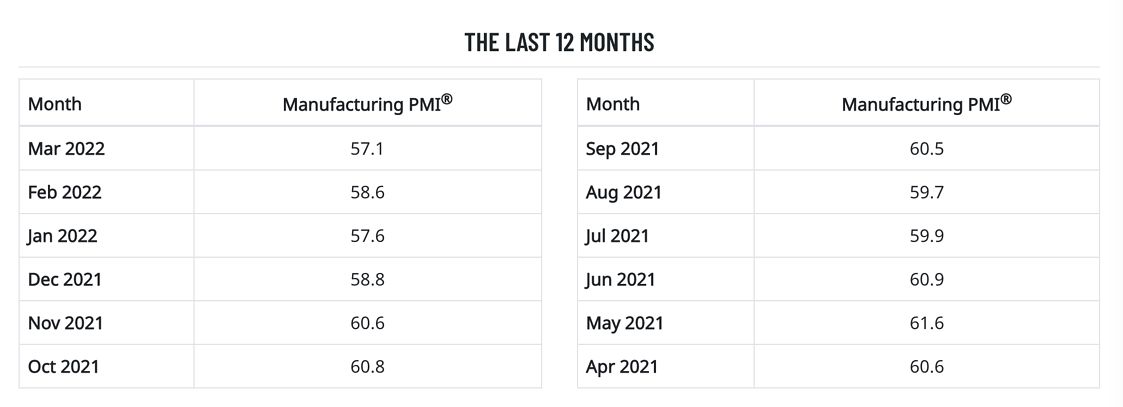In order to effectively manage transportation efforts, especially as the freight market bounces up and down, shippers need insights to understand and accurately predict demand for truckload carriers. No doubt, 1st-party data is “king” because it is specific to the user’s activities. But when 1st-party data is not available, shippers turn to 3rd-party data.
ISM Manufacturing PMI
One of the 3rd-party data sources we like to reference is The Institute for Supply Management (ISM) Purchasing Managers Index (PMI), which is one of the most reliable economic health indicators available. Month-over-month, PMI measures changes in production levels, new orders, supplier deliveries, inventory, and employment. A PMI above 50 suggests growth or expansion in manufacturing, while a PMI below 50 represents a decline. If PMI is 50, there is an equal balance between manufacturing reports of expansion and decline.
The March 2022 index was 57.1, which confirms manufacturing continues to expand. However, that’s a decrease month-over-month (Feb 58.6%). The 12-month average is 59.7, with May 2021 posting the highest month (61.6). Looking longer-term, PMI is expected to be 54 by the end of this quarter, according to Trading Economics global macro models, and closer to 52 in 2023.

Truckload Demand & Pricing
As manufacturing activity levels out, so should the truck-to-load ratio and truckload pricing. Dry van load post volumes are getting close to 2018 levels, decreasing 13% week-over-week. While equipment posts increased by almost the same amount. Dry van load-to-truck ratio dropped 20% week-over-week from 4.3 to 3.41 (4% below 2018 LTR levels). These offer a solid indication that the load-to-truck ratio will continue to contract as we head into Summer. There have been a number of reports by industry experts that have predicted a market shift in the 2nd half of 2022. And so far all signs are pointing in that same direction.
How can Shippers Prepare?
As carrier supply and demand shifts, so should truckload pricing. To deliver goods on time, at a fair market price, shippers have turned to AI-powered software to automate freight procurement. Gone are the days of being reactive to market shifts. Instead, shippers with strong competitive advantage have adopted automation and forecasting tools, to become proactive.
With over 996K for-hire carriers, shippers need to determine if they have a big enough mousetrap to balance service levels with fair market cost. “By replacing an older, linear freight procurement process with an automated one, powered by AI, shippers have reduced truckload cost by 10-20%,” said Michael Paul, VP of Sales at Sleek Technologies. “As manufacturing activity balances out, pricing power shifts from carrier to shipper,” said Paul. “Those who automate freight procurement first will have the competitive advantage, and be empowered to keep up with swift price changes.”

